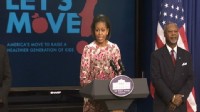By MIKAELA CONLEY
July 12, 2011
Stop the presses, Michelle Obama might have eaten a hamburger.
The blogosphere erupted with criticism almost immediately after the Washington Post reported Monday that the first lady sat down at a newly opened Shake Shack in Washington D.C., where she ordered a ShackBurger, fries, a chocolate shake and a Diet Coke. According to the popular burger joint's website, that's a 1,556-calorie meal.
Many critiqued the first lady's public display of Shake Shack love as she continues to advocate for her
Let's Move! campaign, an initiative to eliminate childhood obesity.
But even as the first lady-turned-health-advocate chowed down on a meal that contains almost an entire day's recommended calorie intake, most nutrition experts are telling people to relax.
"[This is an] unfortunate invasion of privacy for Mrs. Obama," said Alice Lichtenstein, professor of nutrition science and policy at Tufts School of Medicine in Boston. "She has kept her weight constant and engages in regular physical activity. An occasional indulgence is fine. For many people, that is what helps them keep on track most of the time."
Most experts agreed with Lichtenstein, while saying that the first lady's lunch is being unnecessarily scrutinized.
Michelle Obama Remarks on Childhood Obesity
Watch Video Michelle Obama Announces Nutrition Agreement
Watch Video "While the goal for healthy eating is to limit choices like fries and shakes, occasional treats won't hurt. The problem is that many Americans do this more than occasionally," said Connie Diekman, director of university nutrition at Washington University in St. Louis. "It is good to see that even someone as committed to health as the first lady knows that healthy eating is about balance not perfection."
One meal does not make up a dietary pattern, said Dr. David Katz, founder of the Yale Prevention Center.
"She ordered it, but we don't know how much she ate," he said. "Perhaps she did what is often advised under such circumstances; eat half, and wrap up the rest."
Dr. Randall Zusman, director of hypertension at Massachusetts General Hospital, said, "The problem for many persons is that their baseline diets and lifestyles are unhealthy; the norm for them is unhealthy and in that setting, a 1,500-cal lunch is only a small part of a much larger problem."
The first lady has acknowledged her occasional splurge on such foods in the past. Last year, she told ABC News' Robin Roberts, "I love burgers and fries, you know? And I love ice cream and cake. So do most kids. We're not talking about a lifestyle that excludes all that. That's the fun of being a kid. That's the fun of being a human."
Not to say that all medical experts were completely without their concerns.
"There are immediate adverse effects independent of weight," noted Dr. Peter McCullough, consultant cardiologist and chief academic and scientific officer at St. John Providence Health System, Providence Park Heart Institute, Warren, Mich., while citing the immediate cardiovascular implications of the meal.
And Leslie Bonci, director of sports nutrition at University of Pittsburgh Medical, advised via email: "Shake OR fries OR burger, not all 3 at once!"
But Katz of the Yale Prevention Center had advice for those who sought to make an example of the first lady's lunch.
"I invite only those whose diets are housed with no walls of glass to hurl a burger in the first lady's direction on the basis of this one lunch," Katz said.





